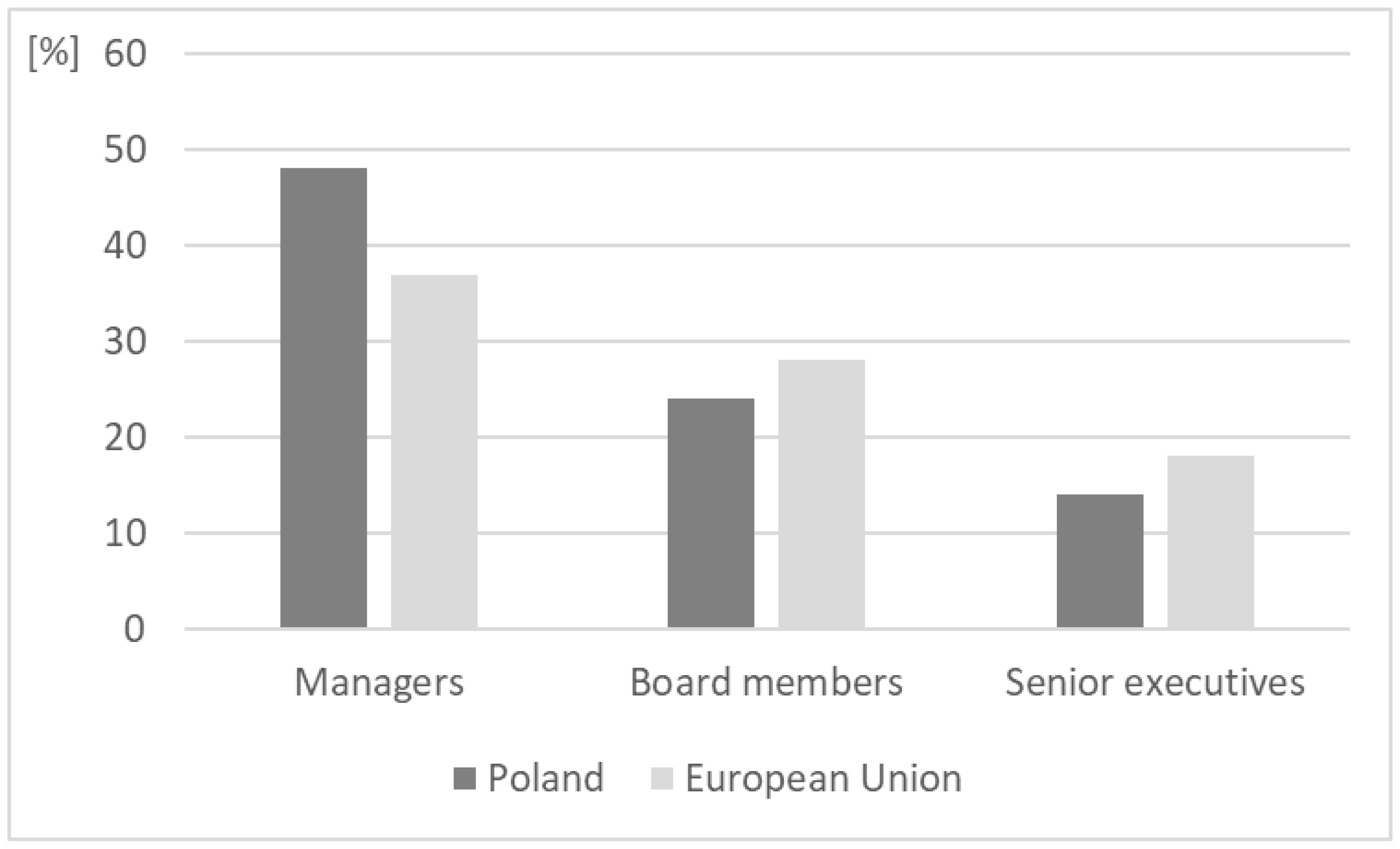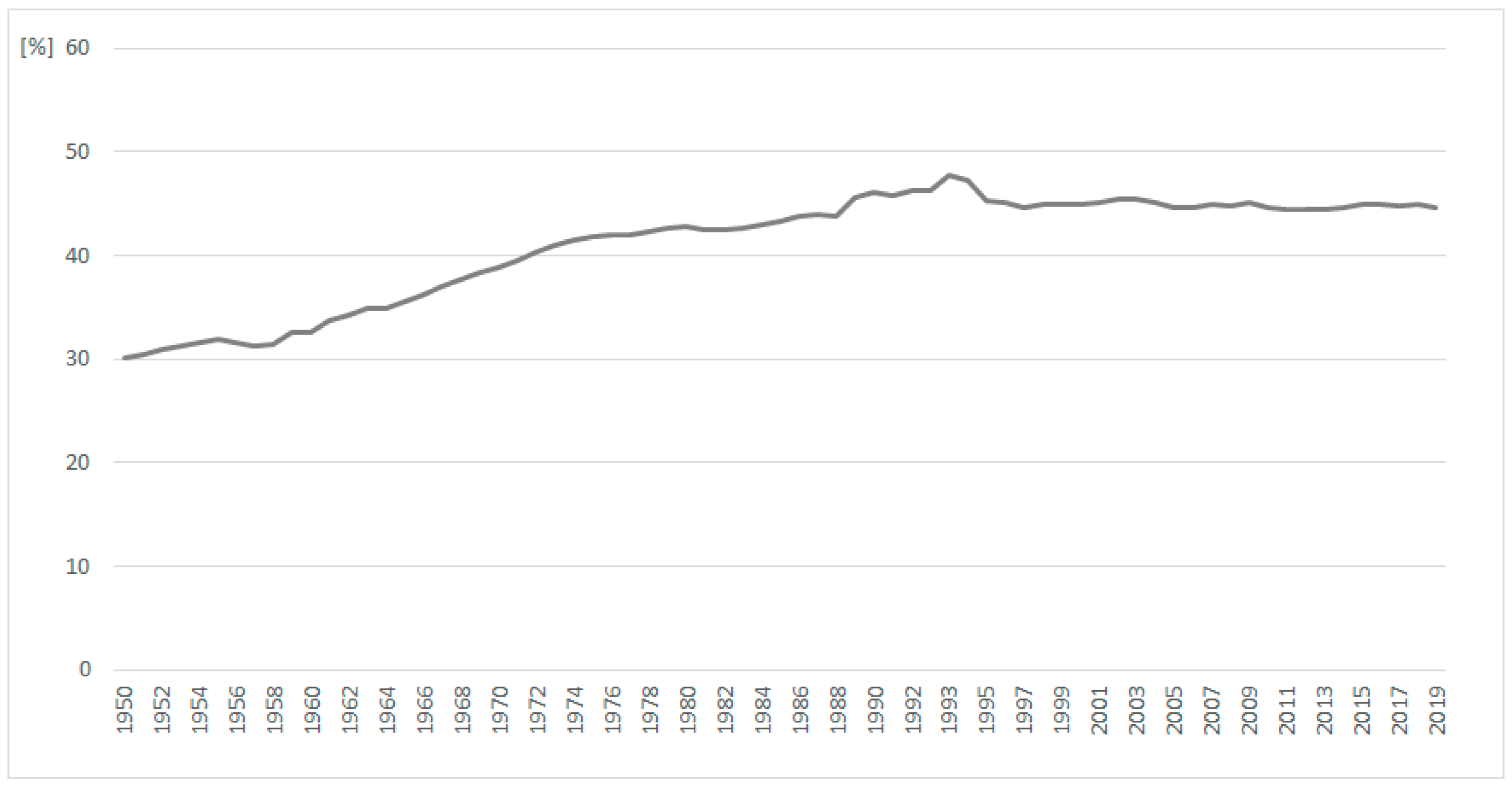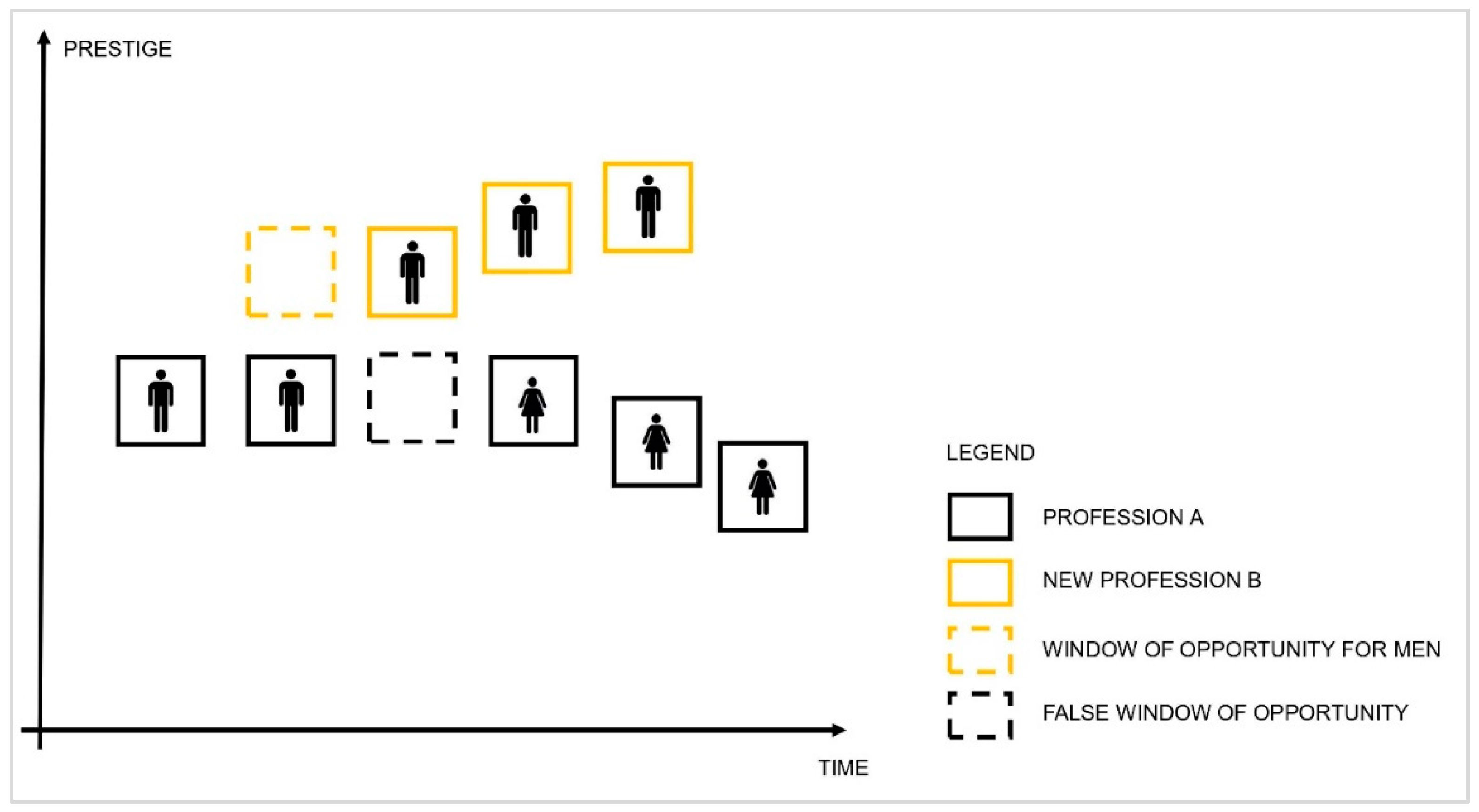200 Years of Feminisation of Professions in Poland—Mechanism of False Windows of Opportunity
Abstract
1. Introduction
Theoretical Framework
2. Materials and Methods
3. Current Situation of Women in the Labour Market in Poland
4. Determinants of the Labour Market in Poland
4.1. Sociocultural Determinants
4.2. Legal Determinants
4.3. Political Determinants
5. Feminisation of the Professions
6. Discussion
7. Conclusions
Funding
Institutional Review Board Statement
Informed Consent Statement
Data Availability Statement
Conflicts of Interest
References
- Eurostat Newsrelease; Eurostat, 2020; Available online: https://ec.europa.eu/eurostat/documents/2995521/10474926/3-06032020-AP-EN.pdf/763901be-81b7-ecd6-534e-8a2b83e82934 (accessed on 5 July 2021).
- Himmelweit, S. Feminist economics. In Rethinking Economics: An Introduction to Pluralist Economics; Fischer, L., Joe Hasell, J., Proctor, C., Uwakwe, D., Perkins, Z.W., Watson, C., Eds.; Routledge: New York, NY, USA, 2017. [Google Scholar]
- Budig, M.J.; England, P. The wage penalty for motherhood. Am. Sociol. Rev. 2001, 204–225. [Google Scholar] [CrossRef]
- Fidelis, M. Women, Communism, and Industrialization in Postwar Poland; Cambridge University Press: Cambridge, UK, 2010. [Google Scholar]
- Pollert, A. Women, work and equal opportunities in post-communist transition. Work Employ. Soc. 2003, 17, 331–357. [Google Scholar] [CrossRef]
- Kiczková, Z.; Farkašová, E. The emancipation of women: A concept that failed. In Gender Politics and Post-Communism: Reflections from Eastern Europe and the Former Soviet Union; Funk, N., Mueller, M., Eds.; Routledge: New York, NY, USA, 1993. [Google Scholar]
- Vinthagen, S. Ten theses on why we need a “Social Science Panel on Climate Change”. ACME Int. J. Crit. Geogr. 2013, 12, 155–176. [Google Scholar]
- Eizenberg, E.; Jabareen, Y. Social sustainability: A new conceptual framework. Sustainability 2017, 9, 68. [Google Scholar] [CrossRef]
- Partridge, E. Social Sustainability. In Encyclopedia of Quality of Life and Well-Being Research; Michalos, A.C., Ed.; Springer: Dordrecht, The Netherlands, 2014; pp. 6178–6186. [Google Scholar]
- Jabareen, Y.R. Sustainable urban forms: Their typologies, models, and concepts. J. Plan. Educ. Res. 2006, 26, 38–52. [Google Scholar] [CrossRef]
- Lisowska, E. Przedsiębiorczość [Entrepreneurship]. In Encyklopedia Gender. Płeć w Kulturze [Gender Encyclopedia. Gender in Culture]; Rudaś-Grodzka, M., Ed.; Czarna Owca Publishing: Warsaw, Poland, 2014. [Google Scholar]
- World Values Survey. Available online: https://www.worldvaluessurvey.org/WVSContents.jsp (accessed on 5 July 2021).
- Poglądy Polityczne Młodych Polaków A Płeć i Miejsce Zamieszkania [Political Views of Young POLES. Gender and Place of Residence]; CBOS (Centrum Badania Opini Społecznej): Warsaw, Poland, 2021; p. 8.
- Modele Życia Małżeńskiego Polaków [Models of Poles’ Marital Life]; CBOS (Centrum Badania Opini Społecznej): Warsaw, Poland, 2020.
- Biały, I.M.C.; Derucka, K.; Łączyńska, M.; Łukasiak, M.; Skrzypczak, I.H.S. Labour Force Survey in Poland, Q1 2018; Biały, I.M.C., Derucka, K., Łączyńska, M., Łukasiak, M., Skrzypczak, I.H.S., Eds.; Statistics Poland (Główny Urząd Statystyczny): Warsaw, Poland, 2019; p. 225. [Google Scholar]
- Local Data Bank. Available online: https://bdl.stat.gov.pl/BDL/start (accessed on 5 July 2021).
- Mahoney, J. Path dependence in historical sociology. Theory Soc. 2000, 29, 507–548. [Google Scholar] [CrossRef]
- Doeringer, P.B.; Piore, M.J. Unemployment and the dual labor market. Public Interest 1975, 38, 67–79. [Google Scholar]
- Doeringer, P.B.; Piore, M.J. Internal Labor Markets and Manpower Analysis; Me Sharpe: Armonk, NY, USA, 1985. [Google Scholar]
- Kryńska, E. The faces of contemporary labour market segmentation. Olszt. Econ. J. 2017, 12, 137–149. [Google Scholar] [CrossRef][Green Version]
- Rosaldo, M.Z.; Lamphere, L.; Bamberger, J. Woman, Culture, and Society; Stanford University Press: Stanford, CA, USA, 1974; Volume 133. [Google Scholar]
- Turner, J.H.; Turner, P.R. The Structure of Sociological Theory; Dorsey Press: Homewood, IL, USA, 1978. [Google Scholar]
- Rosaldo, M.Z. Woman, culture, and society: A theoretical overview. In Woman, Culture, and Society; Rosaldo, M.Z., Lamphere, L., Bamberger, J., Eds.; Stanford University Press: Stanford, CA, USA, 1974. [Google Scholar]
- Bourdieu, P. Masculine Domination; Stanford University Press: Stanford, CA, USA, 2001. [Google Scholar]
- Beck, U.; Lash, S.; Wynne, B. Risk Society: Towards A New Modernity; Sage: London, UK, 1992; Volume 17. [Google Scholar]
- Giddens, A.P.W.S. Sociology; Polity Press: Cambridge, UK, 2009. [Google Scholar]
- Pobłocki, K. Kapitalizm. Historia krótkiego Trwania [Capitalism. History of Short Duration]; Fundacja Bęc Zmiana: Waesaw, Poland, 2017. [Google Scholar]
- Boschma, R. The window of locational opportunity-concept. Collana Teor. Econ. 1996, 60, 1–36. [Google Scholar] [CrossRef]
- Women’s Employment in the EU in 2018. Available online: https://ec.europa.eu/eurostat/web/products-eurostat-news/-/edn-20200306-1 (accessed on 5 July 2021).
- You Gov. Available online: Yougov.co.uk (accessed on 5 July 2021).
- Biały, I.M.C.; Kumor, M.; Łączyńska, M.; Skrzypczak, I.; Strzelecka, H. (Eds.) Labour Force Survey in Poland—I Quarter 2020; Statistics Poland (Główny Urząd Statystyczny): Warsaw, Poland, 2020; p. 49. [Google Scholar]
- Tertiary Education Statistics in 2018. Available online: https://ec.europa.eu/eurostat/statistics-explained/index.php?title=Tertiary_education_statistics (accessed on 5 July 2021).
- Gender Statistics Database—Women and Men in Decision Making 2020. 2020. Available online: https://eige.europa.eu/gender-statistics/dgs (accessed on 5 July 2021).
- Mastercard Index of Women Entrepreneurs 2020 Report; Mastercard, 2020; p. 82. Available online: https://www.mastercard.com/news/media/1ulpy5at/ma_miwe-report-2020.pdf (accessed on 5 July 2021).
- Pilotti, M.A. What Lies beneath Sustainable Education? Predicting and Tackling Gender Differences in STEM Academic Success. Sustainability 2021, 13, 1671. [Google Scholar] [CrossRef]
- Melak, A.; Singh, S. Women’s Participation and Factors Affecting Their Academic Performance in Engineering and Technology Education: A Study of Ethiopia. Sustainability 2021, 13, 2246. [Google Scholar] [CrossRef]
- Women in Science and Technology in 2017. Available online: https://ec.europa.eu/eurostat/web/products-eurostat-news/-/EDN-20190211-1 (accessed on 5 July 2021).
- Stoet, G.; Geary, D.C. The gender-equality paradox in science, technology, engineering, and mathematics education. Psychol. Sci. 2018, 29, 581–593. [Google Scholar] [CrossRef]
- Reddy, A.A.; Mittal, S.; Singha Roy, N.; Kanjilal-Bhaduri, S. Time Allocation between Paid and Unpaid Work among Men and Women: An Empirical Study of Indian Villages. Sustainability 2021, 13, 2671. [Google Scholar] [CrossRef]
- Correll, S.J.; Benard, S.; Paik, I. Getting a job: Is there a motherhood penalty? Am. J. Sociol. 2007, 112, 1297–1338. [Google Scholar] [CrossRef]
- Couch, K.A.; Fairlie, R. Last hired, first fired? Black-white unemployment and the business cycle. Demography 2010, 47, 227–247. [Google Scholar] [CrossRef]
- Kee, H.J. Glass ceiling or sticky floor? Exploring the Australian gender pay gap. Econ. Rec. 2006, 82, 408–427. [Google Scholar] [CrossRef]
- Yagüe-Perales, R.M.; Pérez-Ledo, P.; March-Chordà, I. Analysing the Impact of the Glass Ceiling in a Managerial Career: The Case of Spain. Sustainability 2021, 13, 6579. [Google Scholar] [CrossRef]
- McHale, S.M.; Crouter, A.C.; Whiteman, S.D. The family contexts of gender development in childhood and adolescence. Soc. Dev. 2003, 12, 125–148. [Google Scholar] [CrossRef]
- Martin, C.L.; Wood, C.H.; Little, J.K. The development of gender stereotype components. Child Dev. 1990, 61, 1891–1904. [Google Scholar] [CrossRef] [PubMed]
- Kwiecień, S. Umowa o pracę robotników—polskie regulacje prawne okresu międzywojennego [Workers’ employment contract—Polish legal regulations of the interwar period]. Rocz. Nauk Prawnych 2018, 28, 87–110. [Google Scholar] [CrossRef]
- Goworko-Składanek, B. Ewolucja zasady równości kobiet i mężczyzn aktywnych zawodowo—ujęcie prawno-historyczne [Evolution of the principle of equality between economically active women and men-a legal and historical perspective]. In Kobiety-Praca-Podmiotowość. Refleksje Socjologiczne [Women-Work-Subjectivity. Sociological Reflections]; Kamińska-Berezowska, S., Ed.; Wydawnictwo Uniwersytetu Śląskiego: Katowice, Poland, 2020; pp. 43–56. [Google Scholar]
- Urbańska, M. Nauczycielki województwa śląskiego w czasie ustawy celibatowej (1926–1938) [Female Teachers in the Silesian Province during the Celibacy Act (1926–1938)]. Saec. Christ. 2011, 18, 169–178. [Google Scholar]
- Goldman, W.Z. Women, the State and Revolution: Soviet Family Policy and Social Life, 1917–1936; Cambridge University Press: Cambridge, UK, 1993. [Google Scholar]
- Kopka, J. Czynniki warunkujące podejmowanie pracy nauczycielskiej przez kobiety w Polsce Ludowej na tle procesów aktywizacji zawodowej kobiet [Factors influencing taking teaching jobs by women in the People’s Poland against the background of processes of professional activation of women]. Acta Univ. Lodz. Folia Sociol. 1981, 2, 29–46. [Google Scholar]
- Connelly, J. Captive University: The Sovietization of East German, Czech, and Polish Higher Education, 1945-1956; UNC Press Books: Chapel Hill, NC, USA, 2014. [Google Scholar]
- Tyszka, Z. Rodziny Robotnicze w Polsce: Różnice i Podobieństwa [Working-Class Families in Poland: Differences and Similarities]; Instytut wydawniczy CRZZ: Warsaw, Poland, 1977; p. 211. [Google Scholar]
- Rocznik Statystyczny Pracy 1986 [Yearbook of Labour Statistics 1986]; Sadowski, W., Gradowski, L., Eds.; Główny Urząd Statystyczny: Warsaw, Poland, 1987. [Google Scholar]
- Wyżnikiewicz, B.; Lutostański, K. (Eds.) Praca 1990 [Labour 1990]; Główny Urząd Statystyczny: Warsaw, Poland, 1991. [Google Scholar]
- Siemieńska, R. Nowe Życie w Nowym Mieście [New Life in A New City]; Wiedza Powszechna: Warsaw, Poland, 1969; p. 365. [Google Scholar]
- Mrozek, W. Podstawowe przeobrażenia społeczne w województwie katowickim w okresie XX-lecia PRL [Basic social transformations in the Katowice voivodeship in the period of the 20th anniversary of the People’s Republic of Poland]. Biul. Śląskiego Inst. Nauk. 1965, 51, 5–46. [Google Scholar]
- Frąckiewicz, L. Możliwości i konsekwencje aktywizacji zawodowej kobiet w województwie katowickim [Possibilities and consequences of professional activation of women in the Katowice voivodeship]. Górnośląskie Studia Socjol. 1975, 11, 57–77. [Google Scholar]
- Michalczyk, M. Małżeństwo i rodzina w opinii młodzieży robotniczej [Marriage and family in the opinion of working-class youth]. Górnośląskie Studia Socjol. 1975, 11, 119–166. [Google Scholar]
- Jolluck, K.R. Exile and Identity: Polish Women in the Soviet Union during World War II; University of Pittsburgh Press: Pittsburgh, PA, USA, 2002. [Google Scholar]
- Porter, B. Hetmanka and Mother: Representing the Virgin Mary in Modern Poland. Contemp. Eur. Hist. 2005, 14, 151–170. [Google Scholar] [CrossRef][Green Version]
- Knothe, M.A. Kobiety i praca. Problemy polskiego rynku pracy dla kobiet w okresie przejścia do gospodarki rynkowej [Women and work. Problems of the Polish labor market for women during the transition to the market economy]. In Kobiety Wobec Przemian Okresu Transformacji [Women in the Face of Changes in the Transformation Period]; Faliszek, K., Petras, E.M., Wódz, K., Eds.; Śląsk: Katowice, Poland, 1997. [Google Scholar]
- Reskin, B.F.; Roos, P.A. Job Queues, Gender Queues: Explaining Women’s Inroads into Male Occupations; Temple University Press: Philadelphia, PA, USA, 2009. [Google Scholar]
- McDowell, L.; Massey, D. A woman’s place? In Geography Matters; Massey, D., Allen, J., Eds.; Cambridge University Press: Cambridge, UK, 1984. [Google Scholar]
- Gromkowska-Melosik, A. Feminizacja zawodu nauczycielskiego—“Różowe kołnierzyki” i paradoksy rynku pracy [Feminization of Teacher’s Profession—“Pink Collars” and Paradoxes of Labor Market]. Przegląd Badań Eduk. 2017, 2, 75–90. [Google Scholar] [CrossRef]
- Gromkowska-Melosik, A. Kobieta Epoki Wiktoriańskiej. Tożsamość, Ciało i Medykalizacja [Victorian Era Woman. Identity, Body and Medicalization]; Oficyna Wydawnicza Impuls: Krakow, Poland, 2013. [Google Scholar]
- Oram, A. A master should not serve under a mistress: Women and men teachers 1900–1970. In Teachers, Gender and Careers; Acker, S., Ed.; Psychology Press: Philadelphia, PA, USA, 1989. [Google Scholar]
- Grumet, M.R. Bitter Milk: Women and Teaching; University of Massachusetts Press: Amherst, MA, USA, 1988. [Google Scholar]
- Iwanowski, W. Oświata, Nauczyciele, Liczby [Education, Teachers, Numbers]; Państwowe Zakłady Wydawnictw Szkolnych: Warsaw, Poland, 1973; p. 175. [Google Scholar]
- Teachers in the EU in 2018. Available online: https://ec.europa.eu/eurostat/web/products-eurostat-news/-/edn-20201005-1 (accessed on 5 July 2021).
- Sikorska-Kowalska, M. Emancypacja społeczna i zawodowa robotnic łódzkich przełomu XIX i XX w. [Social and professional emancipation of female workers in Łódź at the turn of the 19th and 20th centuries]. In Studia z Historii Społeczno-Gospodarczej w XIX i XX Wieku [Studies in Socio-Economic History in the Nineteenth and Twentieth Centuries; Puś, W., Ed.; Ibidem Publishing: Lodz, Poland, 2003. [Google Scholar]
- Massey, D. Industrial restructuring as class restructuring: Production decentralization and local uniqueness. Reg. Stud. 1983, 17, 73–89. [Google Scholar] [CrossRef]
- Massey, D. Space, Place and Gender; John Wiley & Sons: Hoboken, NJ, USA, 2013. [Google Scholar]
- Potoczna, M.; Warzywoda-Kruszyńska, W. Kobiety z Łódzkich Enklaw Biedy. Bieda w Cyklu Życia i Międzypokoleniowym Przekazie [Women from Lodz Poverty Enclaves. Poverty in the Life Cycle and Intergenerational Transmission]; Wydawnictwo Uniwersytetu Łódzkiego: Lodz, Poland, 2009; p. 156. [Google Scholar]
- Epstein, C.F.; Coser, R.L. Access to Power: Cross-National Studies of Women and Elites; Routledge: London, UK, 2018. [Google Scholar]
- Sołectwa i sołtysi [Village councils and village administrators]. Stat. Reg. 1968, 15.
- Matysiak, I. Kobiety rządzą polską wsią? Władza lokalna i płeć [Women Rule the Polish Village? Local Authorities and Gender]. Wieś Rol. 2015, 1, 127–141. [Google Scholar]
- Kantowicz, E. Rola kobiet w organizacji działania społecznego i rozwoju szkół [The role of women in organizing social activity and school development]. In Kobiety w Pracy Socjalnej [Women in Social Work]; Kotlarska-Michalska, A., Ed.; Wydawnictwo Naukowe UAM: Poznan, Poland, 2013. [Google Scholar]
- Pokrzywa, M. Feminizacja zawodu pracownika socjalnego [Feminization of a social worker profession.]. Nová Sociálna Edukácia Clov. 2016, 5, 154–164. [Google Scholar]
- Stockman, N.; Bonney, N.; Sheng, X. Women’s Work in East and West: The Dual Burden of Employment and Family Life: The Dual Burden of Employment and Family Life; Routledge: London, UK, 2016. [Google Scholar]
- Antonopoulos, R. The current economic and financial crisis: A gender perspective. Levy Econ. Inst. Work. Pap. Ser. 2009, 1–45. [Google Scholar] [CrossRef]
- Floro, M.; Dymski, G. Financial crisis, gender, and power: An analytical framework. World Dev. 2000, 28, 1269–1283. [Google Scholar] [CrossRef]
- Blanton, R.; Blanton, S.; Peksen, D. The gendered consequences of financial crises: A cross-national analysis. Politics Gend. 2019, 15, 941–970. [Google Scholar] [CrossRef]
- Bronfman, N.; Repetto, P.; Cordón, P.; Castañeda, J.; Cisternas, P. Gender Differences on Psychosocial Factors Affecting COVID-19 Preventive Behaviors. Sustainability 2021, 13, 6148. [Google Scholar] [CrossRef]
- Striving for a Union of Equality The Gender Equality Strategy 2020–2025; European Commission: Brussels, Belgium, 2020.
- Mrozek, W. Górnośląska Rodzina Robotnicza w Procesie Przemian [Upper Silesian Working Class. Family in the Process. of Changes]; Śląski Instytut Naukowy: Katowice, Poland, 1987. [Google Scholar]
- Zjawisko Segregacji Zawodowej Kobiet w Poszczególnych Podregionach Województwa Mazowieckiego [The Phenomenon of Occupational Segregation of Women in Individual Subregions of the Mazowieckie Voivodship]; CBOS (Centrum Badania Opini Społecznej): Warsaw, Poland, 2010.



| Selected Sections in PKD | Total Labour Force (Thous.) | Women (%) | Men (%) | Average Monthly Gross Salary (PLN) |
|---|---|---|---|---|
| Agriculture, forestry, hunting and fishing | 1511 | 38.2 | 61.8 | 5143.58 |
| Mining and quarrying | 229 | 9.2 | 90.8 | 8303.17 |
| Manufacturing | 3301 | 32.5 | 67.5 | 4713.05 |
| Construction | 1318 | 6.4 | 93.6 | 4061.68 |
| Trade; repair of motor vehicles | 2253 | 55.9 | 44.1 | 4306.03 |
| Transportation and storage | 1065 | 22.0 | 78.0 | 4258.86 |
| Information and communication | 432 | 28.5 | 71.5 | 8438.91 |
| Professional, scientific and technical activities | 672 | 53.1 | 46.9 | 6221.76 |
| Administrative and support service activities | 421 | 45.6 | 54.4 | 3716.04 |
| Public administration and defence | 1015 | 50.0 | 50.0 | 5978.14 |
| Education | 1304 | 78.8 | 21.2 | 4863.52 |
| Human health services and social work activities | 979 | 81.5 | 18.5 | 4847.04 |
| Arts, entertainment, and recreation | 234 | 62.0 | 38.0 | 4334.21 |
| Other service activities | 287 | 72.1 | 27.9 | 3706.17 |
| Sector | Initial Degree of Feminisation | Current Degree of Feminisation | Time of Change | Main Reason |
|---|---|---|---|---|
| Education | Average | Very high | First half of the 19th century, very large influx in the 1950s (previously the function of a governess) | Low salaries, lower qualifications, an unattractive profession for men, division of roles |
| Textile industry | Low | Very high | Second half of the 19th century | Lower salaries of women |
| Public administration–village administrator (sołtys) | Low | Medium/High | After 1989 | Low prestige |
| Welfare services | High | High | None | Attribution of specific characteristics to women |
Publisher’s Note: MDPI stays neutral with regard to jurisdictional claims in published maps and institutional affiliations. |
© 2021 by the author. Licensee MDPI, Basel, Switzerland. This article is an open access article distributed under the terms and conditions of the Creative Commons Attribution (CC BY) license (https://creativecommons.org/licenses/by/4.0/).
Share and Cite
Świgost-Kapocsi, A. 200 Years of Feminisation of Professions in Poland—Mechanism of False Windows of Opportunity. Sustainability 2021, 13, 8179. https://doi.org/10.3390/su13158179
Świgost-Kapocsi A. 200 Years of Feminisation of Professions in Poland—Mechanism of False Windows of Opportunity. Sustainability. 2021; 13(15):8179. https://doi.org/10.3390/su13158179
Chicago/Turabian StyleŚwigost-Kapocsi, Agnieszka. 2021. "200 Years of Feminisation of Professions in Poland—Mechanism of False Windows of Opportunity" Sustainability 13, no. 15: 8179. https://doi.org/10.3390/su13158179
APA StyleŚwigost-Kapocsi, A. (2021). 200 Years of Feminisation of Professions in Poland—Mechanism of False Windows of Opportunity. Sustainability, 13(15), 8179. https://doi.org/10.3390/su13158179





